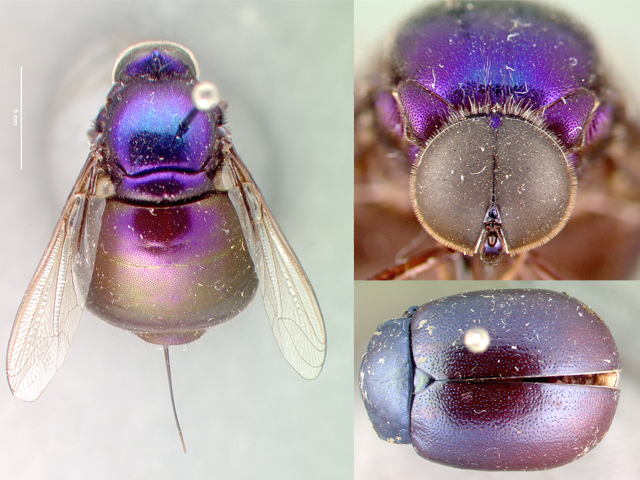 Glass klettii: Apirilaren Nobile egindako argazkiak, CAS
Glass klettii: Apirilaren Nobile egindako argazkiak, CAS
For parte euli gehienak ez dira intsektu bat oso hunkituta lortu dut. Hala ere, Familia-enigmatiko Acroceridae salbuespen dira. Genera interesgarri batzuk partekatzen noizean hasiko naiz – Familiako morfologia amazingly anitza. Nire egun gehienak museoko gure bilduma masiboa inbentarioa baino gehiago gastatu dira 16,000 Acorcerids (aka txiki-buru euliak). Agian ez da soinu guztiak ere konparatu beste familia ugariagoa den zuk ere ikusgarria (eta zurbila egiten du baino gehiago alderatuta 17,500,000 Beste Ale museoan ez dugu); baina bihurtzen da askotan irudikatzeko, ez gehien bada, of guztiak familia osoa aleak ezagutzen. Badira beste instituzioetan euli horiek assemblages litekeena handiak bitartean, California Zientzien Akademia errekorra erraz erreklamatzeko inoiz Dr bilduma jasotzeko geroztik. Evert In. Yaw (noizean behin dator Museotik lan).
Acrocerids buelta talde nahiko zaila izango da nahi izatea, nola arraroak dira naturan zuten aztertzeko, haien biologia parasitoide, eta zein zaila du hegaletik harrapatzeko izan daitezke. Haien thorax handi muskuluak josia dagoela suziria, hegan airean zehar – beraz, ez baduzu harrapatzeko horiek lore bat irrika zu utzi Malaise tranpa bat. Hasiera zuela esan zidan ikaskuntza istorio bat horiek harrapatzeko Costa Rica hegaletik. Downwind stand arloan lankide baten duzu – norbaitek zerbait zip iraganean entzuten bezain laster, dantzan itzeleko kasualitatez unean snare asmoz… it funtzionatzen du behin pixka batean. Euli hauek, gainera, helduen armiarmak mikroorganismoak ezagun bakarra dira (ez Tachinid bat erregistro bat izan daiteke…). Goiko Generoa, NeoGlass, Theraphosid tarantulas parasitoa da (antzeko zerbait Aphonopelma). Unean bere bidea ireki armiarma hankak lan egiten larbak gisa eta sabelaldea bertan, ondoren, liburu biriketako ondoan pausatzen sartu Burrows eta gutxi arnasketa zulo bat zirikatzeak. Ondoren pazientziaz itxaroten gertu heldutasun armiarma. Emakumezkoak tarantulas With, euli hamarkadatan dormant izan daiteke. Azkenean zerbait filma betean Aliens gertatzen da eta larbak armiarma barneko organo elikatzen ondoren azaleratzen den Pupate. Baina armiarma bizkarroi bat, ala ez du out kalkulatzen ezinezkoa da Disekzio gabe – beraz, zuzeneko armiarmak bilduma handiak eutsi behar antolatzailea erregistro lortzeko. Biologia Parasitoides besterik ez da, beraz, cool.
Goiko ale The (Glass klettii berri batean, izenik, Espezie) zen bildu 1977 Schlinger herriko Alamos gertu arabera, Mexikon – litekeena imitatzen modeloarekin loreak, eta Chrysomelidae beetle (beetle pertsona, familia haratago ideiak edozein?).

Very interesting! Out of curiosity, because you mention large collections of live spiders, has any researcher reached out to the hobby tarantula keepers in a quest for specimens? While I have never seen something as spectacular as the above emerge from a wild caught tarantula, I have heard from a few people who ended up with “strange” flies in the past…
Reaching out to them for actual tarantulas has lead to quite a few specimens for Brent Hendrixson on his revision of the genus Aphonopelma, at least for the USA native species. There also are frequently imports of various species brought in from Central and South America, which is not a practice I like or am comfortable with…but it might lead to at least a few specimens given the numbers involved. Just a thought.
I think the answer is somewhat. I’ve reached out on message boards and even recently gave a short talk to the SF Bay Area Tarantula Society. The problem comes down to peoples immediate response when they see a giant grub crawling out of their spider – they reach in and grab their prize specimen and in the process damage the larvae or pupae of the emerging fly. As it turns out these flies are pretty sensitive before pupating and while I’ve seen lots of maggot images, never seen a fly reared by a hobbyist. I think the biggest hurdle is that people only discover what they are after they have had a spider die – and chances are it’ll be years before another one of their wild caught immature spiders are parasitized!
That makes a lot of sense, I guess it didnt really occur to me that for most people having a parasite emerge from one of their captives is a bad thing…that sort of thing would make my day. 🙂
Especially if that spider cost you a few hundred dollars!!
I wonder if that fly sees very well. 🙂
First impression of the beetle is a species of Chrysolina (subfamily Chrysomelinae), but my knowledge of Neotropical chrysos is limited.
Thanks for the genus ballpark – I’ll have to dig through our collections here to see if I can’t narrow it down more.
Did you mean that these acrocerid flies are the only known dipteran endoparasites of adult spiders? There are certainly spider-parasitic nematodes, and mantidfly larvae can crawl into the book lungs of their spider hosts and feed on hemolymph while hitching a ride to the egg deposition site.
http://en.wikipedia.org/wiki/Mantispidae
And here’s a cool post about a mantidfly larva on a spider, preserved in amber!
http://blogs.discovermagazine.com/notrocketscience/2011/03/28/spider-boarding-insect-preserved-in-amber/
(Noski, that one’s on the outside of the spider, but the post also has more info on other tactics.)
Thank you for pointing that out! You’re correct of course, when I was thinking “no other endoparasitoids” I totally neglected non-insects such as nematodes. I should have recalled how tricky it can be to control nematode infestations in captive bread spiders!
I also did not know that about mantidflies. Actually I should catch up on the literature, there may be other diptera or hymenoptera parasitoids more recently known. Very cool, thanks for the link.
Augh augh augh and here’s a picture of a huuuuuge nematode coming out of a spider! It’s even one of the behavior-modifying parasites — it induces its host to seek out water before dying, so the nematode can complete its life cycle. (Like the horsehair worm in crickets!)
http://www.abc.net.au/science/k2/stn/spider.htm